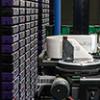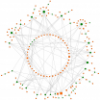The Ohio Supercomputer Center (OSC) recently upgraded two services to allow clients to store more data at a faster rate and strengthen data backup.
Press Releases
Primary tabs
TotalSim US, a computational fluid dynamics (CFD) consulting and solutions firm based in Dublin, Ohio, is helping the state of California certify fuel efficient and environmentally friendly tractor-trailers using resources provided by the Ohio Supercomputer Center (OSC).
Although many college students have access to a personal computer for their studies, it can be challenging for them to learn about how modern, complex computing systems are used in the science, engineering and technology fields without working with the systems directly.
Xia Ning has a large portfolio of research projects at The Ohio State University that focus on understanding how artificial intelligence can be used to solve issues in health care.
With a focus on plant and pollinator species, Colin Campbell, associate professor of physics at the University of Mount Union, studies how these groups interact with one another. Some interactions are mutualistic, where both species benefit, but other interactions are only beneficial for one species. The net effect of many interactions can result in stable or unstable communities, which can be modeled as networks.
Scientists know that plants emit chemicals into the soil to communicate information to other plants. These chemical messages, sent through fungal networks, may warn plants to defend against threats in their environment or to stop encroaching on another plant’s space.
The Ohio Supercomputer Center’s (OSC) Statewide Users Group (SUG) Conference on Thursday, Oct. 7, brought researchers from around the state together virtually. Through Zoom, attendees learned about OSC’s latest services and resources and heard flash talks about research that utilizes the Center’s high performance computing (HPC) capabilities.
The conference emphasized the many ways attendees can engage with OSC beyond SUG meetings. OSC staff highlighted how researchers can make use of available services, learn more about OSC’s impact and help shape future plans.
The Ohio Supercomputer Center (OSC) will serve as a core collaborator in the new NSF AI Institute for Intelligent Cyberinfrastructure with Computational Learning in the Environment (ICICLE), one of 11 such Artificial Intelligence (AI) Research Institutes created as part of a $200 million grant announced today by the National Science Foundation (NSF).
The Ohio State University Molecular and Cellular Imaging Center (MCIC) serves as a shared technology laboratory to facilitate research in microscopy, genomics and bioinformatics. Since its founding in 2000, the center has grown into a data-intensive operation that has thrived in partnership the Ohio Supercomputer Center (OSC).
Efficiency and accuracy are everything in motorsports. Finely tuned engineering workflows must operate on demanding timelines and reliably deliver aerodynamically optimized vehicles. Automotive and industrial company D2H Advanced Technologies relies on the Ohio Supercomputer Center’s (OSC) on-demand high performance computing (HPC) for maximum efficiency in both process and product.








